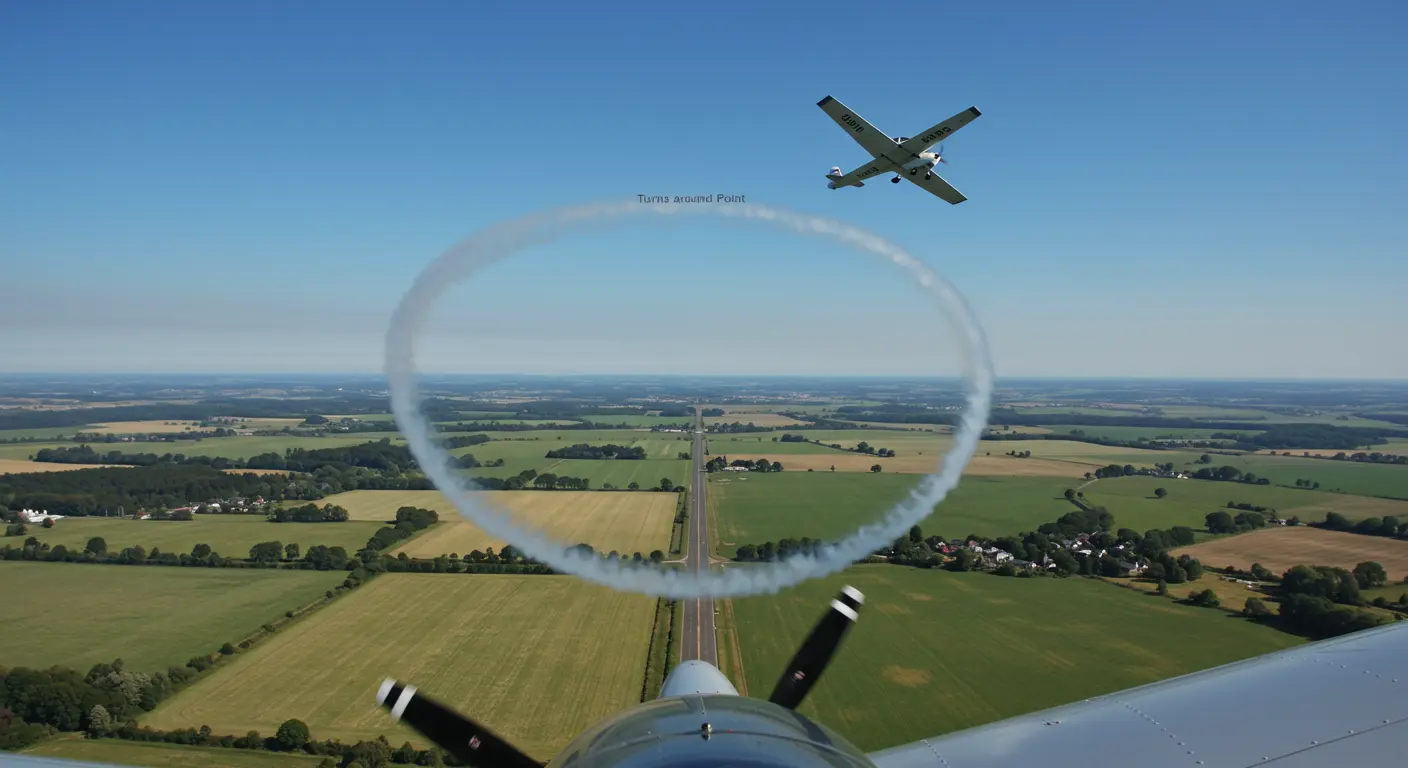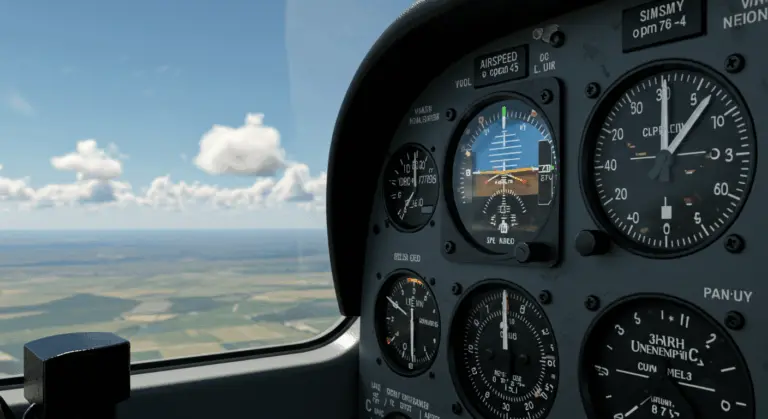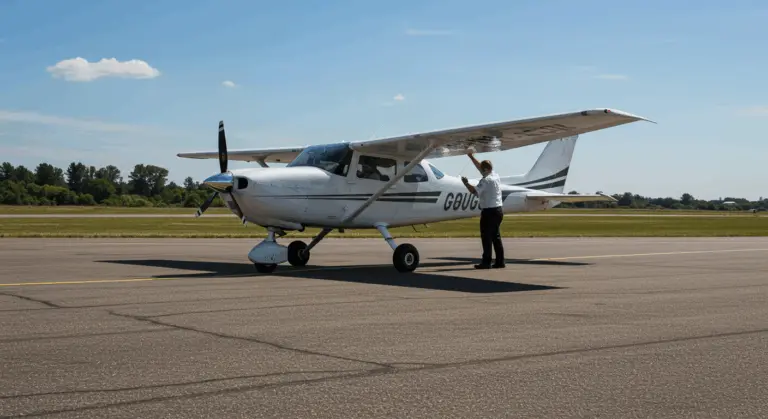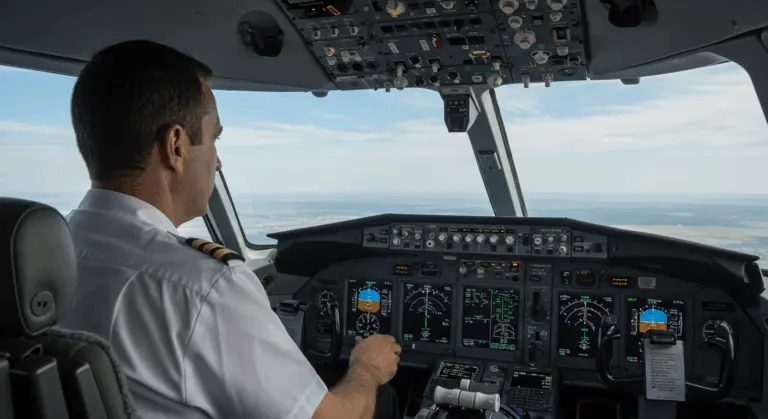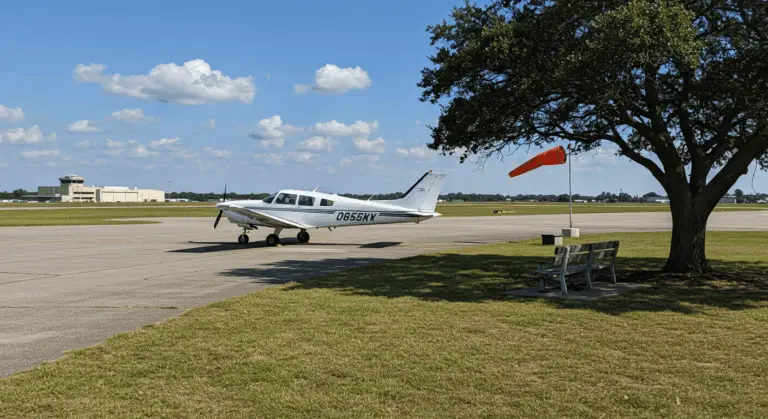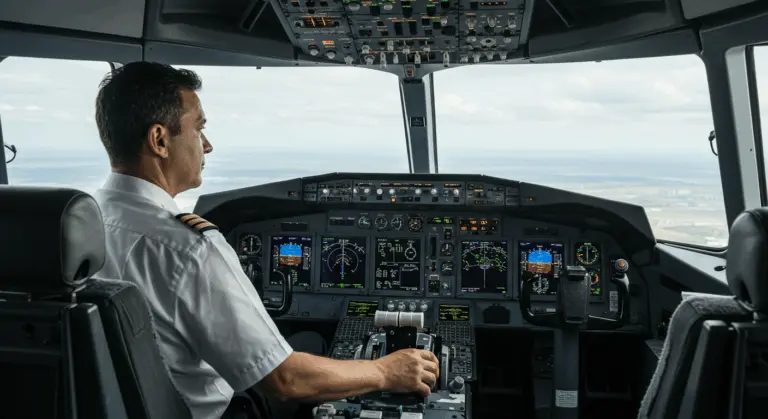Turns Around a Point – A Comprehensive Guide
Understanding Turns Around a Point
Turns around a point represents a fundamental ground reference maneuver that teaches pilots the art of maintaining a constant-radius turn around a ground object. This exercise develops precision aircraft control through continuous bank angle adjustments to compensate for wind effects. This exercise also develops the pilot’s ability to divide attention between flight instruments, ground references, and the aircraft’s flight path.
As a cornerstone ground reference maneuver, it provides the foundation for more complex operations. The skills developed here, such as managing wind drift, directly apply to real-world scenarios like traffic pattern operations and maintaining precise ground tracks, making its mastery a key milestone in every student pilot’s journey.
Key Components of the Maneuver
Executing this maneuver safely and effectively requires three essential elements: selecting a suitable ground reference point, maintaining correct entry parameters, and making continuous adjustments throughout the turn.
The maneuver begins with entering at a safe altitude—typically between 600-1,000 feet above ground level (AGL)—providing adequate obstacle clearance while ensuring clear visibility of ground references. Airspeed must remain below maneuvering speed (VA) to guarantee structural safety during the turns.
The art of effective attention division presents a significant challenge. The pilot must constantly scan between outside visual references (the point, the horizon) and the aircraft’s instruments (altitude, airspeed), while executing precise control inputs that preserve the intended flight path.
Selecting the Right Ground Reference Point
Selecting the ideal ground reference point is the foundational step in performing turns around a point effectively. An optimal reference point must be readily identifiable from altitude and positioned within an area conducive to safe maneuvering. Road intersections, isolated buildings, or distinctive terrain features make excellent reference points as they remain clearly visible throughout the maneuver.
When selecting a reference point, pilots should consider several factors:
-
Safety: The area must be clear of populated areas, obstacles, and restricted airspace.
-
Contingency: The surrounding terrain should offer suitable emergency landing options.
-
Traffic: The location should be free from other air traffic to minimize collision risks.
Maintaining Altitude and Airspeed
Sustaining precise altitude and airspeed control is essential for properly executing turns around a point. The pilot must hold altitude within ±100 feet of the target and airspeed within ±10 knots throughout the maneuver. This precision requires constant attention and continuous adjustment to pitch attitude and power settings as the aircraft’s orientation to the wind changes during the turn.
As the aircraft progresses through its turn, the evolving relationship between flight path and wind direction creates varying lift conditions that directly impact both altitude and airspeed. Countering these effects requires the pilot to apply appropriate back pressure, particularly as bank angles steepen.
Maintaining altitude and airspeed control throughout this maneuver requires developing a cross-check scan pattern that includes both the aircraft’s instruments and outside visual references. The pilot should monitor the altimeter and airspeed indicator while maintaining awareness of the aircraft’s position relative to the ground reference point. This scanning technique applies to other flight operations, such as traffic pattern work and approach procedures.
Executing the Turn Maneuver
Begin by approaching the selected ground reference point from a distance of approximately ¼ mile, at the predetermined altitude and airspeed.
Upon reaching the entry position, the pilot initiates a constant radius turn around the reference point. This requires continuous bank angle adjustments to compensate for wind effects.
During execution, the pilot must maintain a consistent visual scan that includes the reference point, the horizon for attitude reference, nearby obstacles or traffic, and occasional instrument checks to verify altitude and airspeed. This disciplined scanning is essential for maintaining situational awareness while maintaining precise aircraft control. The maneuver typically continues for at least one complete 180-degree turn, though multiple circuits may be performed for practice. The pilot should exit the maneuver with the same precision used throughout, returning to straight and level flight at the completion point.
Adjusting Bank Angle for Wind Correction
Wind correction is the most challenging aspect of turns around a point, requiring continuous bank angle adjustments throughout the maneuver. Flying with a headwind reduces ground speed, necessitating a shallower bank angle to maintain the constant radius around the reference point. Conversely, when flying with a tailwind (turning away from the wind), the aircraft’s ground speed increases, requiring a steeper bank angle to maintain the same turn radius.
Transitions between these extremes require gradual and precise execution. As the aircraft moves from a direct headwind to a direct tailwind position, the bank angle should progressively increase to compensate for the changing ground speed. Similarly, when transitioning from a tailwind to a headwind position, the bank angle should gradually decrease. These adjustments prevent unwanted drift toward or away from the reference point.
Effective wind correction technique typically employs bank angles ranging from shallow (perhaps 10–15 degrees) when directly facing the wind to moderately steep (up to 45 degrees maximum in normal operations) when directly downwind.
Common Errors and How to Avoid Them
Common mistakes in this maneuver include:
-
Inadequate Wind Correction: Failing to properly adjust the bank angle for wind, resulting in an oval-shaped ground track. Correct this with continuous, subtle adjustments based on the aircraft’s position relative to the point.
-
Altitude Deviation: Losing or gaining altitude as the bank angle changes. Fix this by applying appropriate back pressure as the bank steepens and reducing it as the bank shallows.
-
Poor Division of Attention: Focusing too much on instruments or failing to scan for traffic. Maintain a disciplined scan that prioritizes outside references while including brief instrument checks and clearing the area for other aircraft.
-
Overbanking: Exceeding a 45-degree bank angle, which increases stall risk and load factor. Be especially mindful of this tendency during the downwind portion of the turn.
Conclusion: Mastering Turns Around a Point
Mastering turns around a point is an important training milestone that enhances a pilot’s overall proficiency and confidence. The competencies refined through this exercise—precise aircraft control, wind correction, and attention management—transfer directly to critical flight operations like traffic pattern work and final approaches.
A pilot has truly mastered this maneuver when they can a pilot can consistently maintain a constant radius, altitude, and airspeed regardless of wind. This proficiency demonstrates a solid understanding of wind’s effect on the aircraft’s ground track and establishes an essential foundation for safe, precise execution of advanced flight operations.

